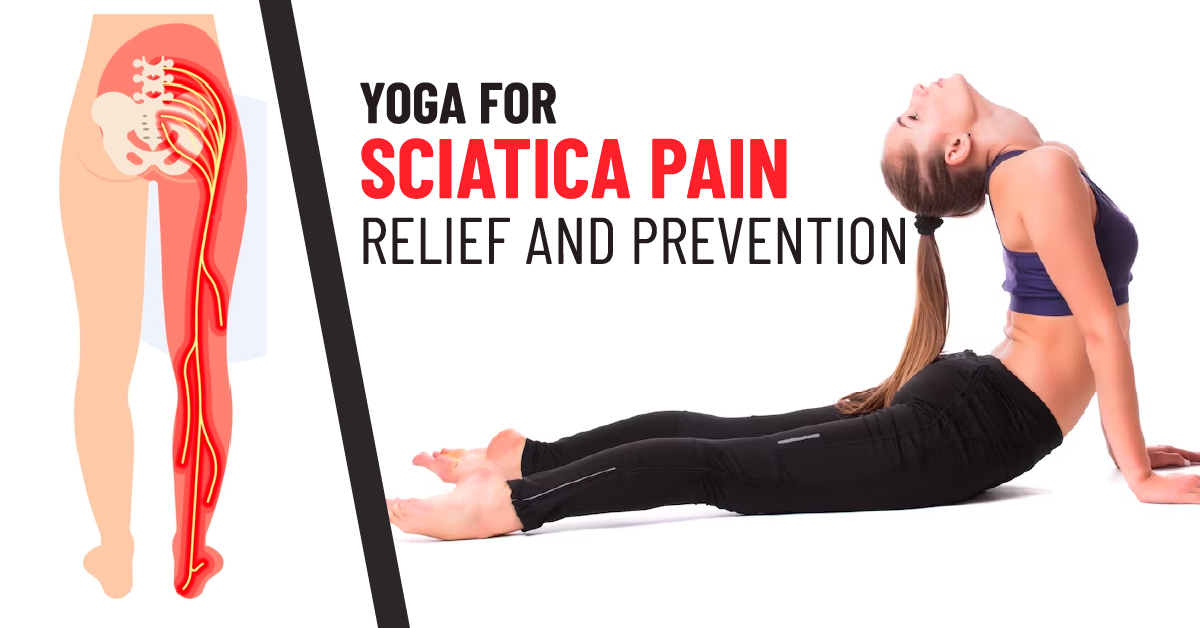5 Effective Yoga for Sciatica Pain Relief and Prevention

Also available in
Are you among the millions of people who experience discomfort from sciatica? This debilitating condition can severely impact your daily life, making even the simplest tasks a challenge. The good news is that yoga, an ancient practice known for its healing and therapeutic benefits, can be a powerful tool in managing and reducing sciatica pain.
In this article, we will delve deep into the world of yoga for sciatica pain, exploring a range of poses and practices to alleviate discomfort and promote healing.
Yoga for Sciatica Pain: Understanding the Connection
Before we delve into the specific yoga poses, it is essential to understand the relationship between yoga and sciatica pain. The sciatic nerve, the largest nerve in the human body, originates from the lower back and travels down through the buttocks and legs.
When this nerve becomes compressed or irritated, it leads to the characteristic pain known as sciatica.
Yoga, with its focus on gentle stretches, strengthening, and relaxation, can target the affected areas, providing relief and support for the healing process.
The Science Behind Yoga for Sciatica Pain
Yoga’s effectiveness in managing sciatica pain is backed by scientific research. Studies have shown that certain yoga poses can reduce inflammation, improve flexibility, and increase blood flow to the affected area, promoting healing. Moreover, yoga encourages the release of endorphins, the body’s natural painkillers, which can significantly alleviate discomfort.
Yoga for Sciatica Pain Relief
1. Child’s Pose (Balasana)
How to Perform:
- Start on your hands and knees with wrists under shoulders and knees under hips.
- Bring your big toes together and widen your knees as you sit back on your heels.
- Exhale and slowly walk your hands forward, lowering your chest towards the floor.
- Rest your forehead on the mat, relax your shoulders, and extend your arms in front of you.
- Breathe deeply and hold the pose for 30 seconds to 1 minute.
Benefits:
- Child’s Pose encourages relaxation by gently stretching the legs, hips, and lower back.
- It can provide relief from sciatica pain by releasing tension in the lower back and hips.
2. Pigeon Pose (Eka Pada Rajakapotasana)
How to Perform:
- Begin in a downward-facing dog position.
- Bring your right knee forward and place it behind your right wrist, aligning the right shin diagonally.
- Extend your left leg straight behind you, keeping the hips square.
- Lower your upper body towards the floor, using your forearms or forehead for support.
- Hold the pose for 1-2 minutes, taking deep breaths into the hip stretch.
- Repeat the pose on the other side.
Benefits:
- Pigeon Pose is a powerful hip opener that stretches the outer hips and glutes.
- It helps alleviate sciatica pain by reducing tightness in the piriformis muscle, which can compress the sciatic nerve.
3. Bridge Pose (Setu Bandhasana)
How to Perform:
- Lie on your back with your knees bent and feet hip-width apart, close to your sitting bones.
- Press your feet into the ground, engage your glutes, and lift your hips towards the ceiling.
- Interlace your hands beneath your body, pressing your arms into the floor for support.
- Hold the position for 30 to 60 seconds while inhaling deeply.
Benefits:
- The Bridge Pose tones the hamstrings, glutes, and back.
- It stretches the chest, neck, and spine, and promotes circulation in the lower back, providing relief from sciatica pain.
4. Thread the Needle Pose
How to Perform:
- Start on your hands and knees with a neutral spine.
- Slide your right arm beneath your left arm, lowering your right shoulder and ear to the floor.
- Keep your left hand firmly planted on the mat for support.
- Hold the position for 30 to 60 seconds while inhaling deeply.
- Repeat on the other side.
Benefits:
- Thread the Needle Pose releases tension in the glutes and lower back.
- It stretches the shoulders and upper back, providing relief from sciatica-related discomfort.
5. Legs Up the Wall Pose (Viparita Karani)
How to Perform:
- Place your body against a wall while sitting.
- Lie down on your back and swing your legs up the wall, forming a 90-degree angle with your body.
- With your palms facing up, place your arms at your sides.
- Close your eyes, relax your body, and breathe deeply.
- Hold the pose for 5-10 minutes, allowing gravity to reverse blood flow and reduce inflammation.
Benefits:
- Legs Up the Wall Pose reduces pressure on the sciatic nerve and lower back.
- It promotes blood circulation, reduces swelling in the legs, and calms the nervous system, easing stress and anxiety.
Yoga Poses to Avoid When You Have Sciatica
While yoga can be beneficial for relieving sciatica pain, it’s crucial to be cautious and avoid certain poses that may aggravate the condition. Here are some poses to steer clear of when you have sciatica:
Forward Folds: Avoid intense forward bends like Seated Forward Bend (Paschimottanasana) as they can compress the sciatic nerve.
Deep Twists: Poses like Full Spinal Twist (Parivrtta Sukhasana) can strain the lower back and exacerbate sciatica.
Standing Forward Bend: Avoid bending forward from a standing position as it can strain the lower back and hamstrings.
Backbends: Full Wheel Pose (Urdhva Dhanurasana) and Camel Pose (Ustrasana) may put pressure on the lower back, worsening sciatica.
Intense Hip Openers: Poses like Cow Face Pose (Gomukhasana) can overstretch the piriformis muscle, leading to sciatic nerve compression.
Plow Pose (Halasana): Avoid this pose as it can compress the cervical spine and stress the lower back.
Always listen to your body and modify your practice accordingly. If you experience pain or discomfort during yoga, stop immediately and consult a healthcare professional or yoga instructor for guidance tailored to your condition. Remember, gentle and mindful practice is key to managing sciatica through yoga.
Conclusion
Yoga for sciatica pain is a holistic and empowering approach to manage discomfort and promote healing. Through gentle stretches, strengthening poses, and relaxation techniques, yoga can effectively target the affected areas and alleviate pain.
Remember to practice with mindfulness and listen to your body’s signals. If you have any underlying health conditions or concerns, consult a healthcare professional before starting a new exercise routine.
With dedication and perseverance, yoga can be a transformative practice in your journey towards improved well-being and pain-free life.
Frequently Asked Questions (FAQs)
How often should I practice yoga for sciatica pain?
The frequency of your yoga practice depends on your individual needs and comfort level. Starting with a few sessions per week and gradually increasing is recommended. Consistency is key to experiencing the benefits of yoga for sciatica pain.
Can yoga alone cure sciatica?
While yoga can be highly effective in managing and reducing sciatica pain, it may not be a standalone cure. It is best complemented with other treatments, such as physical therapy and medication, as prescribed by a healthcare professional.
Is it safe to practice yoga for sciatica pain during pregnancy?
Yes, many yoga poses can be safe during pregnancy and may even help alleviate sciatica pain caused by pregnancy-related factors. However, it is crucial to consult a prenatal yoga instructor and your healthcare provider to ensure the safety of your practice.
Can I do yoga for sciatica pain if I am a beginner?
Absolutely! Yoga offers various poses suitable for beginners that can effectively address sciatica pain. Start with gentle poses and gradually build up your practice under the guidance of a qualified yoga instructor.
Share your thoughts in the comments below if you found this article on yoga for sciatica pain relief helpful. Do not forget to share it with others who might benefit from it.






